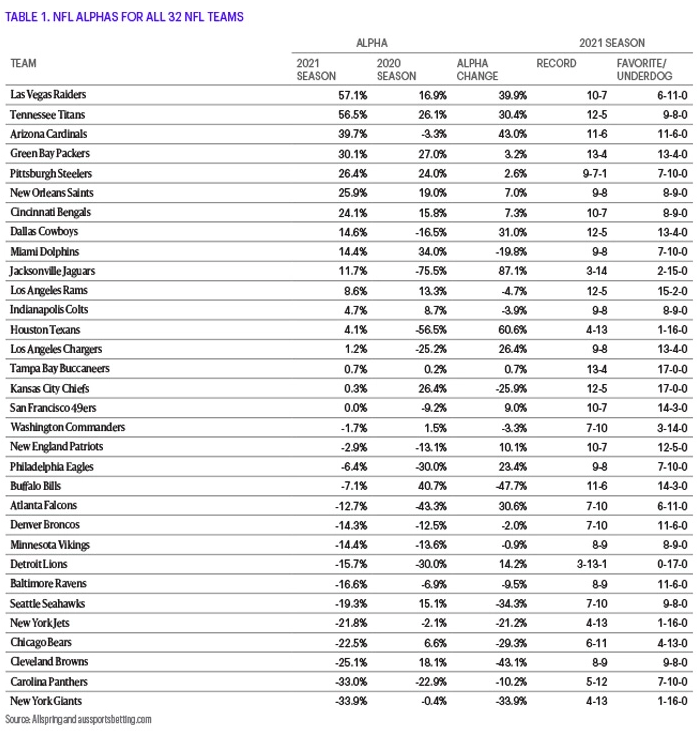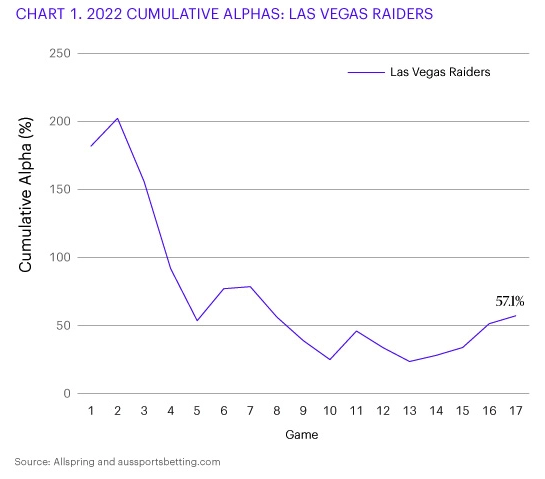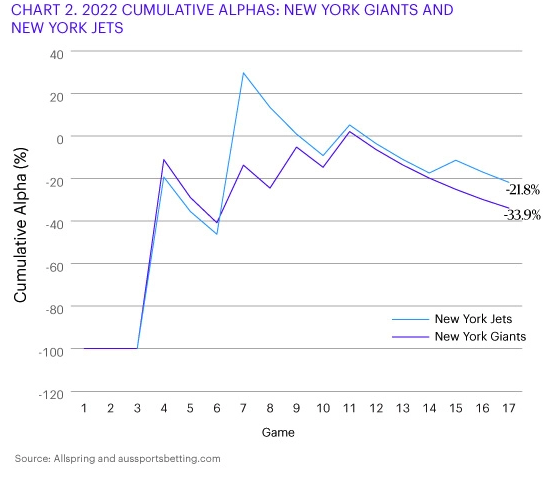The season before we started this annual “NFL Alphas” post, the Tampa Bay Buccaneers defeated the Oakland Raiders (formerly of Los Angeles and now of Las Vegas) in Super Bowl XXXVII. Where the Raiders call home isn’t the only thing that’s changed since then—San Diego (the 2003 host city) now has zero teams while the 2022 host has a fancy new stadium and two teams (one of which will be playing on Sunday).
The past 18 years have been good for equity investors: The S&P 500 Index has delivered an annualized return of 11.88% over that period. Things have also been pretty rosy for the Analytic Investors team’s NFL Alphas annual posts. Our predictive model has correctly identified the undervalued contender in 13 of 18 Super Bowls since we started running it in 2004, including the past 3.
For What It’s Worth
After the Super Bowl left town in 2003, we decided to start applying our quantitative investment management approach to the NFL. We devised a formula—we call it NFL Alphas—that calculates the cumulative return on investment relative to market (wagering) expectations for every team’s 16 (now 17) regular-season games.
To illustrate this concept, let’s use the Bills (the team with the highest Alpha in 2020). We’ll assume a hypothetical bettor places a $100 wager on the “money line” for Buffalo to win in each of their 17 regular-season games. If the Bills lose a game, the bettor has lost $100. If they win, the bettor would collect back the $100, plus an additional sum that’s computed based on the team’s win probability per market expectations. At the end of the season, the bettor adds up all winnings and compares that dollar amount with the $1,700 total wagered throughout the season. Anything less than $1,700 implies a negative Alpha, and anything greater is a positive Alpha. In 2021, the Bills’ wagers delivered $1,579, or a loss to the bettor of $121, which computes as a -7.1% NFL Alpha (Table 1).

Viva Las Vegas
Each year, we like to take a closer look at the Alphas of top- and bottom-ranked teams. The 32nd-ranked team is generally one of the league’s worst performers while the top-ranked team isn’t necessarily in the upper echelon. This was the case in 2021, as the Las Vegas Raiders topped the Alpha rankings. The Raiders’ season played out like a night on the Strip: early success followed by a rough patch in the middle, only to finish with a hot streak. Like Sin City, the Raiders offered plenty of excitement. They notched a 6-2 record in one-score games, including an overtime win on the last day of the season to punch their ticket to the postseason (Chart 1).

A New York State Of Mind
This year’s bottom team was the New York Giants with a paltry -33.9% Alpha, meaning a $1,700 “investment” returned only $1,124. In a show of community solidarity, New York’s other team—the Jets—had a -21.8% Alpha, or $1,329 in proceeds. The fact that these teams were underdogs 16 times in 2021 emulates the low level of expectations that’s normally reserved for the Jacksonville Jaguars. Fear not, Giants fans: The Jags won “Most Improved Alpha” in 2021. They were able to overachieve late in the season to deliver a +11.7% Alpha—a vast improvement over 2020’s -77.5%, which would have turned $1,600 (16 games in 2020) into $392 (Chart 2)!

Major Tom
The other big news last week was that Tom Brady is retiring. Twenty-two years, seven rings, and his ubiquitous GOAT (greatest of all time) status inspired us to reflect on Tom and our Alphas. People, institutions, and algorithms have been underrating Tom Brady for almost a quarter century, and he has pretty consistently proven them all wrong. Of the 18 Super Bowl games for which we’ve shared a prediction, Tom Brady played in nine, winning six. Our model hasn’t been quite as good when there is a “Brady Factor”—going a respectable 5-4 in those nine games compared with 8-1 when Tom was on the beach. Tom has confirmed that this season was his last dance, and we wish him and the rest of the Brady-Bündchen clan all the best in whatever comes next (as long as it’s away from the NFL).








